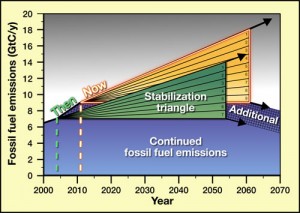RealClimate: The high cost of inaction
In 2004 Stephen Pacala and Robert Socolow published a paper in Science in which they argued that a pragmatic, but still difficult, way of stabilizing atmospheric CO2 levels over the long term was via the implementation of seven “stabilization wedges” over the next 50 years. The idea was very simple: each wedge represented one in-hand technology or societal practice that could be implemented, relatively slowly at first and increasing linearly with time, to make a small but growing dent in the rise in CO2 emissions, stabilizing them at 2004 levels (about 7 Gigatons C/Year) over the next 50 years (see figure below).
These seven wedges would be chosen from among a larger set of fifteen possibilities that included standard mitigation approaches such as increased energy efficiencies in vehicles and buildings, carbon capture at coal plants, nuclear power increases, and reduced deforestation and agricultural tillage-based losses. These practices would collectively buy time while larger scale transformations to renewable energies on a global scale could be developed and implemented that would drive emissions to zero over the following 50 years. This drastic emissions drop in the second 50 year period requires an immediate start on the research needed to develop and implement these technologies five to ten decades out, and the wedges themselves require a deliberate and committed effort, starting now.
A couple of weeks ago, Socolow updated this work in a brief commentary piece to show where we are seven years later. The results are not encouraging. First, and most significant, rather than decreasing the emissions rate, the lack of implementation of these strategies has been accompanied by an accelerated rate of emissions, such that annual CO2 output is now just under 9 Gt C/yr, a 2 Gt/yr increase. Accounting for natural sequestration, this represents an increase of about 13-14 ppm CO2 over that time. But this is not the full story by any means. As Socolow notes, if we re-set the clock to 2011 and start the wedge strategy implementation now, it would now take nine wedges implemented at the proposed rate of the original seven, to accomplish the same goal (keeping emission rates constant over the next 50 years).
 The stabilization wedge concept, circa 2004 vs 2011
The stabilization wedge concept, circa 2004 vs 2011
Here is the real kicker however. Even if we were to do so, starting today, with stable emissions for 50 years and then falling gradually from there to zero emissions over the following 50 years, an additional ~50 ppm of CO2 would be added to the atmosphere by 2111, relative to what would have been added had the seven wedge strategy been initiated in 2004. This equates to a roughly 0.5 W/sq m forcing increase, and a ~0.4 degree C global temperature increase, assuming an equilibrium sensitivity of 3 deg C per CO2 doubling and that the additional 50 ppm is added on top of the increase that would have occurred even if the 2004 wedge strategy had in fact been initiated. In other words, seven years of inaction, even if we immediately begin implementing the strategy now and fully carry it out over the next century, have larger climatic consequences over the next century than one might expect.So are we ready to begin that now, and the research needed for the drastic drops from 2061 to 2111 that the strategy requires, or will we be repeating this same story in 2018, with a couple more wedges required, and another 50 ppm or more likely in the pipeline and no commitment to the needed advanced technologies?
You can read more about it, and commentary on it from some influential folks, here, here, andhere.
The stabilization wedge concept, circa 2004 vs 2011
Sem comentários:
Enviar um comentário